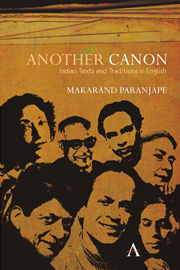Book contents
- Frontmatter
- Contents
- Preface
- 1 Introduction
- 2 Conversations in Bloomsbury
- 3 Comrade Kirillov
- 4 ‘A Horse and Two Goats’
- 5 The Tale of an Indian Education
- 6 ‘Clip Joint’
- 7 Cultural and Political Allegory in Rich Like Us
- 8 Towards Redefining Boundaries
- 9 The Golden Gate and the Quest for Self-Realization
- 10 Journey to Ithaca An Epistle on the Fiction of the 1980s and 1990s
- 11 Cuckold in Indian English Fiction
- 12 Stephanians and Others
- Works Cited
- Index
8 - Towards Redefining Boundaries
The Indo–Canadian Encounter in Days and Nights in Calcutta
Published online by Cambridge University Press: 05 March 2012
- Frontmatter
- Contents
- Preface
- 1 Introduction
- 2 Conversations in Bloomsbury
- 3 Comrade Kirillov
- 4 ‘A Horse and Two Goats’
- 5 The Tale of an Indian Education
- 6 ‘Clip Joint’
- 7 Cultural and Political Allegory in Rich Like Us
- 8 Towards Redefining Boundaries
- 9 The Golden Gate and the Quest for Self-Realization
- 10 Journey to Ithaca An Epistle on the Fiction of the 1980s and 1990s
- 11 Cuckold in Indian English Fiction
- 12 Stephanians and Others
- Works Cited
- Index
Summary
My first move in this essay would be to problematize the notion of boundaries in the words ‘Canadian’ and ‘Indian’. This question becomes especially pertinent when we try to map the connections between these two countries, the most obvious of which is that both are ‘post-colonial’. However different the two post-colonialisms might be, the obvious common ground is in the condition of being what we might call the Other of the metropolis. A common refrain in ‘Canlitcrit’ is the trauma of being marginalized by the two metropolitan cultures of the ‘mother’ countries in Europe and the big bad brother to the south, nearer home. Our difference from the dominant culture of our erstwhile imperial masters and our continuing link with it is also the running theme of modern Indian culture and life. Both countries also share the sense of being marginalized and reduced to a state of inferiority because of such colonization.
In the Canadian imaginary, this feeling has led to what has been called the ‘cringe’ mentality. In his introduction to one such ‘standard’ work on the subject, The Canadian Imagination: Dimensions of a Literary Culture, David Staines cites the correspondence of an early Canadian writer, Susanna Moodie. Moodie wrote two major books whose titles are nothing if not self-explicatory: Roughing it in the Bush (1852) and Life in the Clearing versus the Bush (1853).
- Type
- Chapter
- Information
- Another CanonIndian Texts and Traditions in English, pp. 86 - 100Publisher: Anthem PressPrint publication year: 2009



